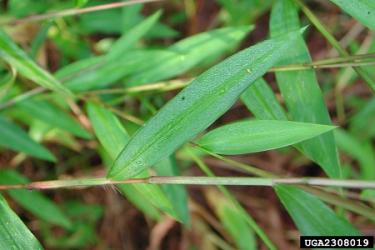When Stiltgrass Attacks
Stiltgrass made its way from Asia to the Americas as a stowaway. The annual grass was first documented in Tennessee in 1919, and was accidentally introduced as a packing material for porcelain. Since then, it has grown readily across the eastern U.S.
This Asian annual grass can be hard to tell apart from several look-alike native grasses, such as Virginia cutgrass (Leersia virginica) and hairy jointgrass. Its leaves are its telltale feature: narrow, lance-shaped and asymmetrical, with a distinctive, pale stripe of reflective hairs on the upper surface. The plant itself resembles a small bamboo and typically grows one to three feet in height in a branching, sprawling manner.
Stiltgrass thrives in a variety of habitats, from the moist ground of open woods and floodplain forests, to wetlands, uplands, ditches and roadsides. It does well in nitrogen-rich soils where mowing, tilling and other soil-disturbing activities happen frequently, and it even does well in shade.
When stiltgrass establishes itself, it begins to spread in two different ways. First, there’s seed: a single stiltgrass plant can produce 100 to 1,000 seeds that can remain viable in the soil for up to five years. The seeds can easily travel, transported by surface runoff, streams and floodwaters, in soil and gravel, and on the feet of animals, including humans.
Then, there’s vegetative spread: the plant roots at joints along the stem, and a new plant can emerge from each node.
Once this process begins and stiltgrass spreads, it can drive out native species that can’t compete with its quick growth. But stiltgrass can be controlled, even if it’s already growing on your property.
How can I get more tips?
It’s simple! Enter your email below.

